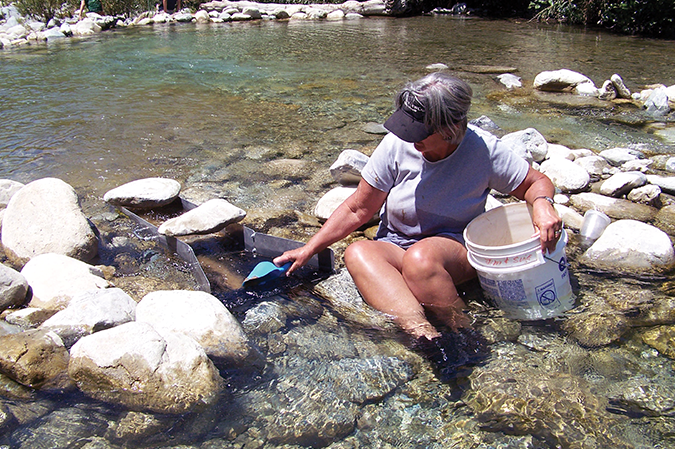"There’s gold in them thar hills!”
You just have to know where to find it.
Actually, gold is all over the region of eastern Stanislaus County, and Calaveras, Tuolumne and Mariposa counties – an area called the Mother Lode. The quest for gold birthed many towns along Highway 49 after the historic discovery of gold by James W. Marshall at Coloma on Jan. 24, 1848. Sutter Creek, Auburn, Jackson, Angels Camp, Jamestown, Columbia, Sonora, La Grange (formerly French Bar) and Mariposa all boomed during the Gold Rush starting in 1849, which changed the landscape of California. Many who came out west quickly became disillusioned by the overstated claims that a person could get rich, so instead they turned to other livelihoods, like freighting, and some found greater fortune by farming wheat in the Valley.
Today gold prospecting remains a popular recreational pastime that has its occasional payoffs. Last September, interest in gold prospecting picked up after news leaked out that Oscar Espinoza of Modesto discovered an 18-ounce gold nugget the size of his palm along Woods Creek near Jamestown. He estimated the find of “Groucho’s Nugget” to be worth $70,000.
That kind of find is more the exception than the rule. Most people who engage in recreational gold prospecting wind up finding little more than flakes, or flour gold (because it’s fine), but even that can add up with time. Sometimes they find nuggets, like the 16-year-old girl who four years ago found a half-ounce nugget she shoveled out of hole at the California Gold Panning operation in Jamestown.
The largest gold nugget found in California came out of the Sierra Buttes in August 1859 and weighed 54 pounds. In July, someone found – with the aid of a metal detector – a five-pound nugget in Butte County worth an estimated $350,000.
Inside Ironstone Vineyard’s jewelry shop and museum in Murphys, one can view a 44-pound chunk of crystalline gold extracted from the Harvard Mine near Jamestown in 1989. It came from a larger piece appraised at $3.5 million but don’t think about stealing it unless you care to be electrocuted by that powered metal bar running through it.
Still some experts estimate that more than 80 percent of the gold in the Mother Lode still has not been recovered.
Prospecting for gold is legal on most public lands in the state. Prospectors must be mindful to be careful not to look for gold on private lands, which can lead to trespassing charges.
Anyone planning to pan for gold on public lands should contact local officials or brush up on any restrictions. Most recreational areas allow recreational gold panning but have established guidelines to prevent stream bank erosion and prevent degradation of the wildland resource. Panning is allowed in Knights Ferry and at Tulloch Lake Road Fishing Access, both controlled by the U.S. Army Corps of Engineers, on the Stanislaus River but only if trowels and pans are used. Panning must be located within two feet of the water’s edge. No dredges or suction devices are allowed.
The California Department of Fish and Game is your contact about suction dredging, which is allowed under a permit process in certain areas.
Panning for gold requires the basic pan, which can be plastic or metal, and a screen or silting pan, called a classifier, for removing larger rocks, and moving water. A hand scoop is also good to have.
As far as technique is concerned, it’s best to fill the pan three-quarters up and begin gentling rocking or swirling the pan at a tilt in the water to let lighter materials be swept away. If done correctly, the only thing that will remain in the pan will be black iron particles and gold flecks or nuggets. At times, other interesting items have been found, such as the time a Waterford man found an 1850’s penny as he panned above the Knights Ferry covered bridge.
For those who don’t know a thing about gold panning and would like to be trained, there are a number of gold excursion businesses that run the gamut of price and length of time.
Gary Thomas, a 52-year-old former Monterey mechanic, runs California Gold Panning, 17712 Harvard Mine Road, Jamestown, (209) 916-5166. He obtained his license from the California Department of Fish and Game to run an operation on a lease of seven acres along Woods Creek. The company offers different packages depending on whether a person just wants access to gold-bearing creek sites with their own equipment; or if they want lessons and to lease equipment like the “high banker” which can run a bucket in three seconds.
“We get beautiful gold but I just don’t post it,” said Thomas, who is not a fan of social media.
Most people don’t strike it rich but a person operating a high banker can collect a gram a day in a good spot, or an ounce per month, he said. Gold is running $1,320 per ounce.
“It’s still good recreational fun,” said Thomas. “It’s so peaceful and serene down there. It’s fun to teach people how to do it and they keep the gold they find.”
The heavy rainfall this year has created better-than-normal conditions. In some instances, swollen streams have pushed over older trees, exposing spots that haven’t been available for decades. Roots of trees and vegetation often trap gold. Thomas said he recently panned out a spot where an 80-year-old tree was uprooted and recovered a quarter-gram in 90 minutes.





